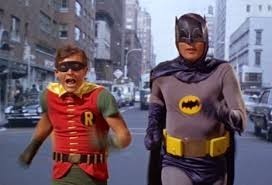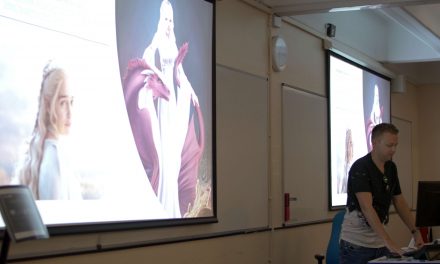One of the strange things about the people in soaps is that they don’t appear to watch television. Recently in EastEnders we have had several sights of a character slumped on the sofa with a faint sound of a soundtrack on the soundtrack. But the television soon gets switched off without comment and the story resumes.
 Probably the most famous on-screen television in film studies remains that Christmas present to Cary (Jane Wyman) in All That Heaven Allows (Universal/Sirk/1955). As she realizes that her children are going to leave the family, the blank screen returns her own image – cinema’s perfect critique of the isolated viewer. I was recently re-viewing a couple of Kay Kendall films from the 1950s which also feature television. In the first, Meet Mr Lucifer(Ealing/Pelissier/1953), the television set is literally the object of the devil
Probably the most famous on-screen television in film studies remains that Christmas present to Cary (Jane Wyman) in All That Heaven Allows (Universal/Sirk/1955). As she realizes that her children are going to leave the family, the blank screen returns her own image – cinema’s perfect critique of the isolated viewer. I was recently re-viewing a couple of Kay Kendall films from the 1950s which also feature television. In the first, Meet Mr Lucifer(Ealing/Pelissier/1953), the television set is literally the object of the devil and is so destructive of domestic harmony that is quickly passed on to the next victim. It ends up with a repressed, young man (a Scottish Presbyterian played by Gordon Jackson) who falls in love with Kendall as the Lonely Hearts Singer who seductively pulls him closer to the screen. The film plays with the difference between a television star,positioned within the frame of the tv set and directly addressing her foolish audience (Fig.1),and the cinema star, obliterating the frame of the screen and singing to us in the cinema (Fig2). It doesn’t quite come off – the close-up is surely too close for early television – but the ambivalence of cinema merging in and out of television is suggestive.
and is so destructive of domestic harmony that is quickly passed on to the next victim. It ends up with a repressed, young man (a Scottish Presbyterian played by Gordon Jackson) who falls in love with Kendall as the Lonely Hearts Singer who seductively pulls him closer to the screen. The film plays with the difference between a television star,positioned within the frame of the tv set and directly addressing her foolish audience (Fig.1),and the cinema star, obliterating the frame of the screen and singing to us in the cinema (Fig2). It doesn’t quite come off – the close-up is surely too close for early television – but the ambivalence of cinema merging in and out of television is suggestive.
A later Kendall film, Simon and Laura (Rank/Muriel Box/1955) told the tale of a warring married couple played by Kendall and Peter Finch. They are theatrical stars who find new fame in a television soap. Rather like a contemporary reality show, the serial takes aspects of their real life (a Christmas party is televised from their own living room and their servants have supporting roles) but gives them a script to work with. The film gives us different aspects of television including a version of the layers of BBC bureaucracy and the working-class audience. Rather than the isolated viewer, here is the classic family audience: mum with her knitting, dad ready to kick the set when reception wavers, grandma and noisy children – a boy and a girl, of course. Rather than being quiet and absorbed, this audience is rumbustious and argumentative, indicating the difficulties Simon and Laura will have when the programme’s ratings begin to fall (Fig 3). But television’s influence is clear; when Simon and Lauran fall into a drunken argument at their Christmas party, rows break out in front of the set (Fig 4).
wavers, grandma and noisy children – a boy and a girl, of course. Rather than being quiet and absorbed, this audience is rumbustious and argumentative, indicating the difficulties Simon and Laura will have when the programme’s ratings begin to fall (Fig 3). But television’s influence is clear; when Simon and Lauran fall into a drunken argument at their Christmas party, rows break out in front of the set (Fig 4).

Over Christmas, an addition to my collection of ‘television on screen’ moments appeared with the present of a BBC DVD of The Tony Hancock Collection. It included a 1959 episode, written by Ray Galton and Alan Simpson, ‘The Set that Failed’, in which Hancock has to face a night without television when his 1936 set breaks down (‘Have you been kicking it?’ asks the repair man. ‘Course I have! How do you think I change the channel?’.) This television version of television includes and extends the cinematic stereotypes and
 provides a neat resume of all the objections being made while television spread its tentacles across the UK in the 1950s. Hancock starts as an isolated viewer faced with ‘one whole night without television’; surely, he thinks, he can do ‘better things . . . become an intellectual’ perhaps. But he is reduced to adopting his usual position in front of the screen (Fig 5) and imagining what’s on, a task which should be easy since ‘it’s always the same’: The Adventures of Long John Silver (Aus/1957 (UK)) allows for an impression of Robert Newton as Long John Silver while the theme tune of The Adventures
provides a neat resume of all the objections being made while television spread its tentacles across the UK in the 1950s. Hancock starts as an isolated viewer faced with ‘one whole night without television’; surely, he thinks, he can do ‘better things . . . become an intellectual’ perhaps. But he is reduced to adopting his usual position in front of the screen (Fig 5) and imagining what’s on, a task which should be easy since ‘it’s always the same’: The Adventures of Long John Silver (Aus/1957 (UK)) allows for an impression of Robert Newton as Long John Silver while the theme tune of The Adventures of Robin Hood(UK/1955-59) occasionally drifts in. Sid James shortly enters and expresses his contempt for Hancock’s dependency and suggest he has a ‘wonderful chance to break free’: ‘why don’t you read a book?’. That fails so Sid tries to get a conversation going but once the weather and the colour of Sid’s sock are exhausted (Fig 6) every topic reverts to television. Hancock is agonized by thinking that Marshall Matt Dillon might choose that night to be killed in Gunsmoke (US/1955-75).
of Robin Hood(UK/1955-59) occasionally drifts in. Sid James shortly enters and expresses his contempt for Hancock’s dependency and suggest he has a ‘wonderful chance to break free’: ‘why don’t you read a book?’. That fails so Sid tries to get a conversation going but once the weather and the colour of Sid’s sock are exhausted (Fig 6) every topic reverts to television. Hancock is agonized by thinking that Marshall Matt Dillon might choose that night to be killed in Gunsmoke (US/1955-75).
 Despite berating Hancock for the ‘terrible grip [television] has’ over him, in the second part of the episode, Sid joins Hancock in pursuit of a television to watch for the evening. This of course involves assaulting the remarkably resilient barricades of other people’s homes. Hancock’s upper-class neighbor has ‘company’ – lined up on the sofa watching Robin Hood (Fig 7) – and doesn’t intend for his uncouth visitor to infiltrate his way in. Hancock’s Uncle Fred and Aunt Edie
Despite berating Hancock for the ‘terrible grip [television] has’ over him, in the second part of the episode, Sid joins Hancock in pursuit of a television to watch for the evening. This of course involves assaulting the remarkably resilient barricades of other people’s homes. Hancock’s upper-class neighbor has ‘company’ – lined up on the sofa watching Robin Hood (Fig 7) – and doesn’t intend for his uncouth visitor to infiltrate his way in. Hancock’s Uncle Fred and Aunt Edie at first seem more friendly, greeting him warmly and so keen to hear his news that they insist on turning the television off: ‘very rude to keep it on with visitors here’ (Fig 8). (I remember this etiquette which was agony before the days of VCR). Hancock rushes off disgruntled and it is only then that we learn this is a ruse. Far from reflecting the inclusive family of a pre-tv era, Uncle Frank has calculated a way of getting rid of unwanted guests: ‘That’s the way to get rid of them. Switch the tele off. I hate visitors’.
at first seem more friendly, greeting him warmly and so keen to hear his news that they insist on turning the television off: ‘very rude to keep it on with visitors here’ (Fig 8). (I remember this etiquette which was agony before the days of VCR). Hancock rushes off disgruntled and it is only then that we learn this is a ruse. Far from reflecting the inclusive family of a pre-tv era, Uncle Frank has calculated a way of getting rid of unwanted guests: ‘That’s the way to get rid of them. Switch the tele off. I hate visitors’.
 Finally Sid, using binoculars, spots a television viewing session in a house over the road.We cut to a family sitting absorbed in front of the screen. New entrants are greeted by name (they are expected to enter the house at the usual time as they come home from work) but are not visually checked so Hancock and Sid can pass for Tommy and Jack to join the viewing (Fig 9). There is soothing music on the soundtrack and conversation – ‘dinner in the oven when you’re ready’ – takes on the dreamy tone which was
Finally Sid, using binoculars, spots a television viewing session in a house over the road.We cut to a family sitting absorbed in front of the screen. New entrants are greeted by name (they are expected to enter the house at the usual time as they come home from work) but are not visually checked so Hancock and Sid can pass for Tommy and Jack to join the viewing (Fig 9). There is soothing music on the soundtrack and conversation – ‘dinner in the oven when you’re ready’ – takes on the dreamy tone which was  later a feature of The Royle Family (UK/1998-). Even the news that one of the sons has lost his job can’t change the absent-minded engagement which television imposes on all other social interactions:
later a feature of The Royle Family (UK/1998-). Even the news that one of the sons has lost his job can’t change the absent-minded engagement which television imposes on all other social interactions:
Son: Daaad, I got the sack today.
Dad: Did you?
Son: Yeees
Domestic tasks are done with eyes on the  screen: Hancock makes and passes round a cup of tea but, as they drink it, no-one notices that he’s left out tea-leaves (Fig 10); the table is laid and food brought out. Finally, the real Tommy and Jack announce their entry (‘Can’t be’ says Dad on hearing but not seeing who they are.‘You’re already here’. ‘Shhh’ says the daughter). Hancock and Sid slip away unobserved, Tommy and Jack take their rightful places and no-one’s eyes leave the screen in the process (Fig 11).
screen: Hancock makes and passes round a cup of tea but, as they drink it, no-one notices that he’s left out tea-leaves (Fig 10); the table is laid and food brought out. Finally, the real Tommy and Jack announce their entry (‘Can’t be’ says Dad on hearing but not seeing who they are.‘You’re already here’. ‘Shhh’ says the daughter). Hancock and Sid slip away unobserved, Tommy and Jack take their rightful places and no-one’s eyes leave the screen in the process (Fig 11).
In the coda, the repair man reports that Hancock’s television is mended. As he settles down to watch, he rejects the attempted entry of his upper-class neighbour whose own set has now broken. Of course when Hancock turns his set on, the screen dissolves into a series of wavy lines. In an ending which Meet Mr Lucifer also used, he announces lugubriously that he’s ‘going to the pictures’ and thus back to the cinema.
It’s interesting that the programme collects up and makes fun of so many of the criticisms that were being made of television by the sociologists and educationalists of the 1950s in terms of the quality of television’s technology and the effect on the audience. But perhaps ‘The Set that Failed’ had two things going for it in terms of this critique. Its audience could remember a time before television and was resolutely determined not to go back to that; and the programmes which so absorb Hancock and his fellow television addicts were all ITV favourites. The BBC could still claim to be above it all.
Christine Geraghty is an Honorary Professorial Fellow at the University of Glasgow and an Honorary Research Fellow at Goldsmiths, University of London. Her publications on television include a contribution to the 1981 BFI monograph on Coronation Street; Women and Soap Opera (Polity, 1991); and My Beautiful Laundrette (I B Taurus, 2004). Her BFI TV Classic on Bleak House (2005) will be published in October 2012. Her BFI TV Classic on Bleak House (2005) was published in October 2012. She is on the editorial board of the Journal of British Cinema and Television and sits on the advisory boards of a number of journals, including Screen.
The Hancock episode is available on DVD and on various websites including Youtube.
For discussion of the two British films see Charles Barr, ‘Broadcasting and cinema 2: Screens within screens’ in C. Barr (ed), All Our Yesterdays, London: British Film Institute, 1986 and Christine Geraghty, British Cinema in the Fifties: Gender, Genre and the ‘New Look’, London: Routledge, 2000.





